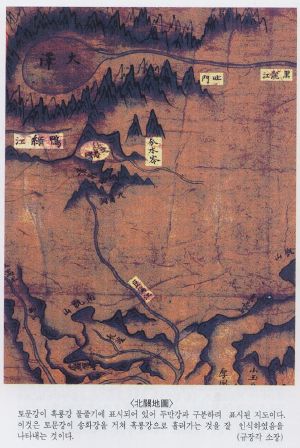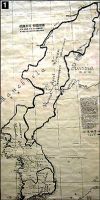Difference between revisions of "Jiandao" - New World Encyclopedia
Dan Davies (talk | contribs) (claimed) |
Dan Davies (talk | contribs) m (started) |
||
| Line 1: | Line 1: | ||
| − | {{claimed}} | + | {{started}}{{claimed}} |
{| cellpadding=3px cellspacing=0px bgcolor=#f7f8ff style="float:right; border:1px solid; margin:5px" | {| cellpadding=3px cellspacing=0px bgcolor=#f7f8ff style="float:right; border:1px solid; margin:5px" | ||
|- | |- | ||
Revision as of 21:03, 5 September 2007
| Chinese name | |
|---|---|
| Traditional Chinese | 間島 |
| Simplified Chinese | 间岛 |
| Pinyin | Jiāndǎo |
| Wade-Giles | Chien-tao |
| Japanese name | |
| Kanji | 間島 |
| Hepburn Romaji | Kantō |
| Korean name | |
| Hangul | 간도 |
| Hanja | 間島 |
| Revised Romanization | Gando |
| McCune-Reischauer | Kando |
Jiandao (間島), known in Korean as Gando, refers to northeastern parts of the People's Republic of China that are populated mostly by Koreans. The area is approximately 31,000 square kilometers in size and home to about a million ethnic Koreans.[2] Jiandao Province (間島省) was also one of the provinces of Manchukuo, an Imperial Japanese puppet state in Manchuria during World War II. Its capital was Yanji.
Today, most of the region is part of Yanbian Korean Autonomous Prefecture, a part of Jilin Province of the People's Republic of China (PRC). In China, Yanbian (延邊; Yenbyen 옌볜, or Yŏnbyŏn 연변 in Korean) is the usual name used, and Jiandao is rarely used, due to its association with Japanese occupation. North Korea and South Korea recognize the region as a part of the People's Republic of China, but there are some groups in South Korea that claim the region as a historical part of Korea.
History
Multiple states succeeded each other in ruling the area in ancient times. These included Goguryeo and Balhae. The first, called Goguryeo (called Gaojuli by Chinese), is acknowledged as one of the Three Kingdoms of Korea. The second, called Balhae (Bohai in Pinyin) was a state that existed in the area during the Tang Dynasty in China and the Unified Silla Period in Korea. China emphasizes Balhae's temporary tributary relationship to the Tang, while Korea claims that Balhae was a cultural extension of Goguryeo.
Balhae was destroyed by the Khitan Liao Dynasty in 926, and formally annexed in 936. For the next several centuries the region changed hands between the Khitans, Jurchens, Mongols, and finally, the Manchus, whose Qing Dynasty succeeded in conquering China and forcing submission from the Joseon Dynasty in Korea.
In 1712, the border between Qing and Joseon was formally demarcated. For years, Qing officials did not allow people to move to Manchuria, as it always believed that should a Han majority government rise again in China, the Manchu royalty can flee to this area and retain a strong base to recover control in China. Joseon officials also did not allow its subjects to move to Manchuria. These governmental regulations with the general marshy nature of the area left Gando undeveloped and sparsely inhabited for a long time. However, by late 19th century, significant amount of Koreans were moving into Manchuria, and even more arrived as refugees when Korea became a colony of Japan in 1910. During this period of time, the interpretation of the 1712 boundary agreement became subject to dispute, as was Gando's ownership (see below).
In 1905, the Korean Empire became a protectorate of Japan, effectively losing diplomatic rights. In the early 20th century, Korean immigration to Manchuria steadily increased, either fleeing from Japanese rule, or encouraged by the Japanese government to develop the land. Some Chinese local governments welcomed the Korean immigrants as they were a source of labor and agricultural skill.
On April 18, 1906, a team of Japanese military invaded Gando and declared ownership over the region. In the Gando Convention of 1909, Japan affirmed territorial rights of the Qing over Gando after the Chinese foreign ministry issued a thirteen-point refutation statement regarding its rightful ownership. The treaty also contained provisions for the protection and rights of ethnic Koreans under Chinese rule. Nevertheless there were large Koreans settlements and the area remained under significant Japanese influence.
Despite the agreement, Koreans in Gando continued to be a source of friction between the Chinese and Japanese governments. Japan maintained that all ethnic Koreans were Japanese nationals, subject to Japanese jurisdiction and law, and demanded rights to patrol and police the area. The Qing and subsequent local Chinese governments insisted on its territorial sovereignty over the region.[1]
After the Mukden Incident, the Japanese military invaded Manchuria. Between 1931 to 1945, Manchuria was under the control of Manchukuo, a Japanese client state. Jiandao was a province of Manchukuo. This period initiated a new wave of Korean immigration, as the Japanese government actively encouraged (or forced) Korean settlement in order to colonize and develop the region. After World War II and the liberation of Korea, many Korean expatriates in the region moved back, but a significant majority still remained in Manchuria; descendants of these people form the Korean ethnic minority in China today.
The area is now the Yanbian Korean Autonomous Prefecture in Jilin province.
Boundary claims
Korean claims over Gando stem from what is perceived as an ambiguity in the original Sino-Korean boundary agreement.
After several attempts by the Kangxi Emperor to negotiate the issue, in 1712, the Joseon of Korea and Qing of China agreed to dilineate the boundaries of the two countries at the Yalu and Tumen Rivers. The Qing delegation was led by Mukedeng, and the Joseon delegation was led by Pak Kwon, and the two held a joint commission to survey and demarcate the boundaries between the two states. Efforts were taken to locate the sources of the Yalu and Tumen rivers at Mt. Paektu (Baitou). Owing to Pak's age, they agreed for Mukedeng's team to ascend the summit alone. Mukedeng's team quickly identified the source of the Yalu, but identification for the Tumen proved more complicated. At last a spot was decided, and a stele was erected as a boundary marker. Over the next year, a fence was built to demarcate the areas where the Tumen river ran underground.
Pak Kwon was instructed by the Joseon government to retain all territory south of the Yalu and Tumen rivers, a goal he accomplished. However, some Korean officials lamented the loss of claims on areas north of the river and criticized Pak Kwon for not accompanying Mukedeng to the summit. The territorial claims stem from the territories held by Goguryeo and Bohai, ancient states in Manchuria from which Koreans claimed heritage. Nonetheless, the border remained uncontentious for the next 150 years. Cross-border movements were forbidden, and was punishable by death after trespassers were detained and repatriated back to their respective countries.
In the 1870s the Qing government reversed its policy of prohibiting entry to Manchuria, and began allowing Han Chinese settlers into the territory in response to growing Russian encroachment. The area around Gando was opened up to settlement in 1881, but Chinese settlers quickly discovered some Korean farming communities already settled in the area. Despite the decreed punishment, severe droughts in northern Korea motivated Korean farmers to seek new lands. The Jilin general-governor Ming-An's official response was to lodge a protest to the Joseon government and offer to allow the Korean population to stay if they agreed to become Manchu subjects and adopt Qing customs and dress. Joseon's response was to encourage the farmers not to register as Qing subjects but to return to Korea within the year.[2]
The farmers, unwilling to abandon their homes, argued that because of the ambiguity in the naming of the Tumen river, they were actually already in Korean territory. The Yalu (鴨綠) / Amnok (압록) River boundary is of little dispute, but the interpretation of the Tumen River boundary 土門 (토문) causes problems. The name of the river itself originates from the Jurchen word tumen, meaning "ten thousand". The official boundary agreement in 1712 identified the Tumen river using the characters 土門 (pinyin:tǔmen) for the phonetic transcription. However, the modern Tumen River is written as 圖們 (pinyin:túmen) in modern Chinese and as 豆滿 (두만) "Duman" in both modern Korean and Japanese. Some Koreans hence claim that the "Tumen" referred to in the treaty is actually a tributary of the Songhua River. Under this interpretation, Gando (where the Koreans settled) would be part of Korean territory.[3]
This confusion arises as the two names sound identical, and neither name is actually of Chinese origin. The two rivers can be seen in the following map from the period. Korean claims are based on maps that show separate "Duman" and "Tumen" rivers. However, it is uncertain which modern river the Korean claim corresponds to, as there is no modern tributary of the Songhua River with that name:
- Satellite view of same location; Baekdu Mountain, Lake Tianchi, and the Tumen River are visible
- Satellite view of the Songhua river and Baekdu Mountain, for comparison purposes
This interpretation of the boundary gradually developed into Joseon official policy. O Yunjung, a Korean official appointed to review the claims made by the farmers and investigate the sources of the river, adopted the latter interpretation and declared that the region did not belong to China. Joseon and Qing officials met in 1885 and 1887 to resolve the dispute, but with little result. Korean officials suggested on starting from the stele and tracing the river downwards, while Qing officials proposed starting at the mouth of the Tumen River and moving upstream.[4] From 1905 onwards, Korea came under the influence and control of Japan and was unable to effectively pursue these claims.
After liberation of Korea in 1945, many Koreans believed that Gando should be given to Korean rule, but the military control by United States of America in the south and Union of Soviet Socialist Republics in the north hindered any unified Korean claim to the territory. The chaos of the Korean War and the geopolitical situation of the Cold War effectively diminished any opportunity for Koreans to highlight the Gando issue. In 1962, North Korea signed a boundary treaty with People's Republic of China setting the Korean boundary at Yalu and Tumen, effectively foregoing territorial claims to Gando. South Korea also recognizes this as the boundary between Korea and China.
Today, none of the governments involved (North Korea, South Korea, People's Republic of China, or Japan) make the claim that Gando is Korean territory. In addition, there is very little enthusiasm for irredentism among the Korean minority in China. Although there are occasional arguments over historical interpretation, this issue arouses very little emotion or official interest on the part of any of the parties, and relations between China and both Koreas remain warm.
In 2004 the South Korean government issued a statement to the effect that it believed that the Gando Convention was null and void. The resultant controversy and strong negative reaction from the PRC led to a retraction of the statement, along with an explanation that its issuance was an "administrative error."
A small number of South Korean activists believe that under a unified Korea, the treaties signed by North Korea can be deemed null, allowing the unified Korea to actively seek regress for Gando. However, the current political situation make this a faint possibility at best. Also, some scholars claims that China's efforts to incorporate the history of Goguryeo and Balhae into Chinese history is an effectively pre-emptive move to squash any territorial disputes that might rise regarding Gando before a unified Korea can claim such or the Korean ethnic minority in the Manchuria region claim to become part of Korea.
Images
The following maps, made by Korea from the 1700s to the 1800s, show Sino-Korean borders to be aligned along the Yalu and Tumen rivers, essentially the same as those today:
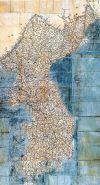
|
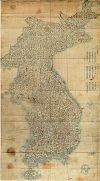
|
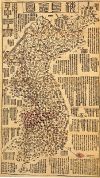
|
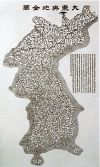
|
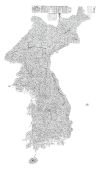
|
Korean claims to Gando are based on other maps. The following were made by western missionaries. However, the first is explicitly stated as a map of "Quan-Tong Province" (now Liaoning province, China) and Kau-li (Korea), and the second is stated as a map of the Chinese Tartary (la Tartarie Chinoise). Compared to the Korean-made maps above, the coastlines and rivers are also significantly less accurate; nor do these maps following the Sino-Korean border at the Yalu/Amnok River, which is not ambiguous:
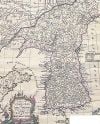
|
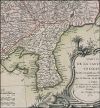
|
Note that two almost identical versions of a first map exists, showing significant differences in the border. One shows the boundaries similar to modern-day province and country borders, while the other shows the Sino-Korean border significantly further north.

|
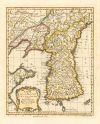
|
The following map, also used to support claims, is a map of Roman Catholic Apostolic vicariates during the early 20th century. At this time, Korea is divided under three Apostolic vicariates; Seoul (originally Corea erected in 1831 by Pope Gregory XVI, Daegu erected in 1911 by Pope Pius X, and Wonsan erected in 1920 by Pope Benedict XV, which, as can be seen in the map, extends throughout both eastern Manchuria, including Gando, as well as northern Korea. This is taken as proof that eastern Manchuria is "Korean", rather than the converse hypothesis that northern Korea is "Manchurian".
ReferencesISBN links support NWE through referral fees
- ↑ Erik W. Esselstrom (2000). Rethinking the Colonial Conquest of Manchuria: The Japanese Consular Police in Jiandao, 1909–1937. Modern Asian Studies 39: 39-75.[1]
- ↑ Schmid, pg. 226-227 The border did not become a bone of contention again until almost 150 years later—the second moment pointed out in Chang Chiyon’s work. In the 1870s Qing authorities began to open Manchuria, shut off from Han migration since the earliest years of the dynasty. In various stages between 1878 and 1906 the entire expanse of Manchuria opened to settlement; the Tumen River valley received its first legal Han settlers in 1881. When these Qing settlers arrived, however, they quickly discovered that many more Koreans had already begun farming much of the best land. By 1882 the presence of large Korean communities in the region came to the attention of the general of Jilin, Ming An, who proceeded to lodge a protest with the Choson court, laying down a number of conditions: so long as these Koreans paid taxes to the court, registered their households with local authorities, recognized the legal jurisdiction of the Jilin authorities, and shaved their heads in the Manchu style—in short, become Qing subjects—they were welcome to stay; otherwise they should return to Choson territory. Seoul responded by urging Ming An not to register their subjects, for within one year they would all be returned home—an agreement that seemed to accept Qing land claims. For the farmers themselves—people who had fled famine conditions and labored for more than ten years to bring land under cultivation—a move off the lands hardly proved a favorable scenario. Few left. By April of the following year the head of the Huichun Resettlement Bureau had again demanded of local Choson authorities that by the conclusion of the fall harvest the farmers be returned to the other side of the river.
- ↑ Schmid, pg. 227 Their position centered on an interpretation of the stele erected by Mukedeng more than two centuries earlier. The farmers contended that they had never crossed any boundary and were in fact within Choson territory. Their argument skillfully played off the ambiguity surrounding the character engraved on the stele to represent the first syllable in the name of the Tumen River. They argued that Qing officials had failed to distinguish between two different rivers, both called something like Tumen but written with a different character signifying the first syllable. One, the character on the stele, indicated earth; the second, a character not on the stele, signified what today is considered the tu for Tumen River, meaning diagram. The river behind which the Qing officials demanded the farmers withdraw was the latter. As argued by the farmers, though the pronunciation was nearly identical, the different characters signified two distinct rivers. The first Tumen River delineated the northernmost extreme of Choson jurisdiction, while a second Tumen River flowed within Choson territory. Qing authorities mistakenly believed the two rivers were one and the same, the petition suggested, only because Chinese settlers had falsely accused the Korean farmers of crossing the border. In fact their homes were between the two rivers, meaning that they lived inside Choson boundaries. The way to substantiate their claims, they urged, was to conduct a survey of the Mt. Paektu stele, for in their opinion the stele alone could determine the boundary.
- ↑ Schmid, pg. 227-228 At this time O Yunjung, who later became a famous reform official, was appointed as special inspector for the Northwest. Upon receiving his appointment, O informed the king in wonderful Confucian rhetoric that the farmers would “naturally return” as they learned of the king’s sagely virtue, but when he arrived at the frontier, he quickly learned sagely virtue was no match for land. He immediately heard the complaints of the farmers. In response, O undertook two investigations, the first to verify the position and text of the Mt. Paektu stele, the second to ascertain the sources of the river. The results of these efforts sufficiently confirmed the position of the farmers, and O, in an audience at court, confidently eased the king’s doubt about their claim to these lands. “That these lands are not the lands of China,” he stated, “is most clear.” From this point what had been a view circulating only at the local level among residents developed into official policy. By 1885 and 1887, when Choson and Qing delegates met along the border to survey the local topography with the hope of ending the disagreement, the Choson negotiators had adopted the interpretation of the stele as the basis of their negotiating stance. Start at the stele, they told their Qing counterparts, and trace the river downward from this point. The Qing side rejected this emphasis on the stele. Instead, the opposite method of locating the border was suggested: start at the mouth of the Tumen River and trace the river upstream, regardless of the positioning of the stele. A number of surveys were conducted, but more accurate information on the local topography did little to soften the opposing positions on determining the boundary.
Hyun Ok Park (2000). Korean Manchuria:The Racial Politics of Territorial Osmosis. The South Atlantic Quarterly 99 (1): 193-215.[3]
Andre Schmid (2000). Looking North toward Manchuria. The South Atlantic Quarterly 99 (1): 219-240.[4]
See also
- Gando Convention
- Yanbian Korean Autonomous Prefecture
External links
- Gando New Source of Friction Seoul, Beijing Brace for Fresh Round of Historical Bout
- China shock for South Korea
Credits
New World Encyclopedia writers and editors rewrote and completed the Wikipedia article in accordance with New World Encyclopedia standards. This article abides by terms of the Creative Commons CC-by-sa 3.0 License (CC-by-sa), which may be used and disseminated with proper attribution. Credit is due under the terms of this license that can reference both the New World Encyclopedia contributors and the selfless volunteer contributors of the Wikimedia Foundation. To cite this article click here for a list of acceptable citing formats.The history of earlier contributions by wikipedians is accessible to researchers here:
The history of this article since it was imported to New World Encyclopedia:
Note: Some restrictions may apply to use of individual images which are separately licensed.
